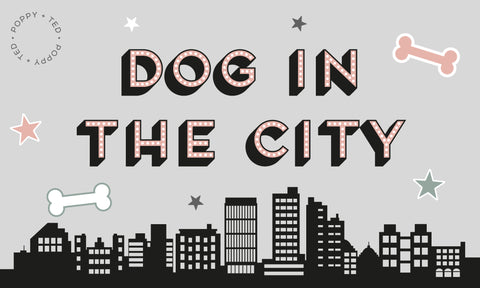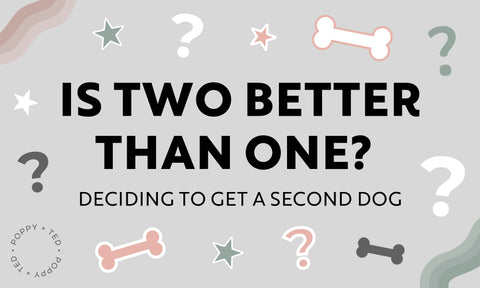 Whether you’re welcoming a puppy into your home or are adopting an older dog, adjusting them to a flat or apartment might sound daunting. You might even be questioning whether it’s a good idea to have them in an apartment in the first place.
Whether you’re welcoming a puppy into your home or are adopting an older dog, adjusting them to a flat or apartment might sound daunting. You might even be questioning whether it’s a good idea to have them in an apartment in the first place.
Well, we are here to tell you that it's entirely possible and that you shouldn’t have to subject yourself to a dog-free life just because you live in a flat. Dogs living in flats or apartments can have lives just as fulfilling as dogs left to roam around a farm all day, and the size of the homes they live in doesn’t mean they receive any less love.
So, to help convince you and equip you with all the knowledge, expertise and advice you need for making your dog comfortable in your flat, keep reading!
Can You Have a Dog in a Flat?
Let’s start by answering the question you’re most likely asking yourself, can you have a dog in a flat? Well, there are several reasons why this concern might have popped into your mind. From the safety and fulfilment of your pup to even the legalities behind the new addition to your home, find the answers you seek here.
Is it Safe?
Firstly, is it safe to have a dog living in a flat?
The answer is yes! It’s entirely ‘safe’ for your dog to live in a flat or apartment, and, with their smaller size, it’s much quicker and easier to pet-proof your space. Just remember that the fewer things that can be knocked over, the better. Low-hanging breakables and trip hazards like trailing wires need to go. You should also position fragile and breakable ornaments high up or tuck them away in cupboards.
We also know that many flat owners like to decorate their space with houseplants to bring the outdoors in. Still, you must ensure that none of these is particularly harmful or toxic for your pet.
If you have a balcony, take precautions to stop dogs from trying to jump over fences or slip through railings. You can do this by adding an extra trellis or other decoration that limits your pup’s curiosity about what’s beyond the balcony.
Is it Legal?
Next, you need to consider if you’re allowed to keep a dog, or any pet for that matter, in your flat. If you rent your property, you must consider your lease agreement and consult your landlord’s pet policy. Some landlords will accept dogs on the property, but you should also be aware that this consent can be revoked if an agreement is breached. For example, if it is found that your dog creates a nuisance through noise or damage.
If you own the freehold to the flat, you can’t be prevented from owning pets!
Is it Ethical?
Finally, you might have questioned whether it’s cruel to keep a dog in a flat, and we want to alleviate your concerns on this one too. The only cruelty your dog could face is if they are neglected, underfed and understimulated. Living in a flat does not equate to any of these things; poor owners do!
As long as you keep your dogs happy and healthy, living in a flat should not affect them.
Dogs are sociable creatures, so you should not be leaving them alone for extended periods. Consider whether you have a dog-friendly office space with which you can take your furry companion to work with you. If not, make arrangements for a dog sitter or walker to come and spend some time with your pup when you cannot.
You should also ensure your dog feels comfortable and give them their space. It's important to set boundaries if there are areas of your flat where you would prefer your dog didn’t roam, like your bed, but there needs to be a balance so that your dog can find their own comfort. We recommend leaving treats in areas of the flat where you think your pup might be most comfortable and adding mats, blankets or toys to set spaces for play and rest.
How to Toilet Train a Dog in a Flat
One of the biggest concerns people face when considering keeping a dog in a flat is toilet training. Of course, it is more difficult if you do not have a garden to toilet train your dog, but that doesn’t mean it's impossible. All you need is time and patience!
Training Your Dog to Use an Indoor Toilet
You might want to consider investing in an indoor toilet for your dog. If you’ve never heard of one before, just imagine a cat litter tray with a covering of fake grass that your dog will respond to.
Here are some tips to help you get started:
- Take your dog to the indoor toilet after feeding or playtime.
- Set a command phrase, like ‘go to toilet’ complete with pointing.
- Do not give your dog attention when on the toilet. It's important they understand only one thing happens.
- Give them plenty of praise once they have done their business.
- If you notice your dog sniffing around the toilet, give them plenty of encouragement to reduce anxiety.
Toilet Training Your Dog for Walkies
Getting your dog to do their business while on walks is much easier, especially because it is instinctually for them to leave their ‘mark’.
However, to begin this routine, you will need to take them on many more walks than you might have thought. For example, we recommend taking them out on their lead when you wake up, after naps, after meals and again before you go to bed. This eliminates the risk of your pup going potty inside your flat.
By developing a steady routine, which all dogs crave, you help them understand that walk time is also potty time. You should also remember to stick to a feeding schedule, as this will translate into a poop schedule!
If you have a balcony, that is a great emergency toilet spot whether you train them to go out there or use it for upset tummy emergencies.
Teaching Your Dog to Be a Good Neighbour
Lastly, you might be conscious of a dog in the flat disrupting the peace of your neighbours, whether they’re next door, above or below you. But as long as you take the time to train your pooch, there's no reason gey can’t be a good neighbour that people delight in passing in the hall or stairway.
If your dog is particularly anxious and the sounds of your neighbours startle them, try introducing noise machines. This can help acclimatise them to the surrounding area and discourage them from making noise back.
You can also train your dog with the ‘put a sock in it’ method. This teaches your dog to grab a toy in their mouth whenever they feel the urge to bark. It’s best practice to allow your dog to bark just once when startled or excited and then use the command to encourage them to be quieter. Once your dog has successfully remained quiet, reward them for their good behaviour!
If you’re leaving your dog alone in the flat at all, build them up to this rather than leaving for an hour with no warning. Start by leaving them alone for just a few seconds, then a few minutes and slowly build the time up from there.
Welcoming your Dog Home
Are you ready to welcome your pooch into your flat and life?
We hope we have helped alleviate some of your concerns about having a pup in your flat, so that you are ready to meet your new furry best friend. But what about once you have found your new pet?
Make sure you’re equipped with all the essentials you need to help transition your dog into their new lives, with collars, leads and harnesses from our collection. We have everything you need for safe and stylish walks with your pup, and plenty of accessories to make the whole experience as easy as possible.
Plus, you can find expert grooming supplies also on offer.



